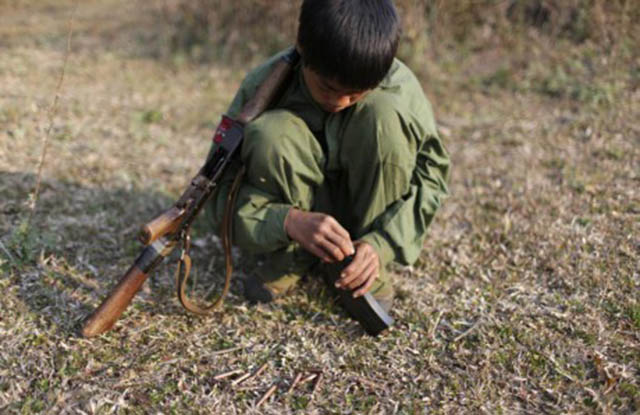Insurgency has intensified within recent months and a large number of civilians were reportedly killed, mainly in 2015. Afghan children are particularly left at the mercy of militancy and used as a cannon fodder by the Taliban and like minded insurgent groups. Children suffered several challenges in the country within the last three decades of war, especially during the Taliban’s regime, and their pain and anguish have no more been mitigated. It is believed that children bear the brunt of problems and Afghanistan is an unlucky place for them. Female children fall victim to violence and rape and male children are vulnerable to acts of terror.
Drops of blood still trickle down from the wounds of children’s bodies riddled with bullets in battlefield – the children who fell for the Taliban’s mouth-watering promises and were naïve enough to succumb to their radical ideology. Recruiting children as soldiers was rife among the Taliban from the very beginning. I remember vividly when a large number of children were studying in madrasahs during their regime in every nook and cranny of the country. Their minds were loaded with fundamental dictations to propel them for militancy and terror.
Based on Human Rights Watch research, the Taliban have been training and deploying children for a range of military operations including the production and planting of improvised explosive devices (IED). In Kunduz province, the Taliban have used madrasahs as hotbed of terror and to provide military training to teenagers many of whom have been deployed in combat.
“The Taliban’s apparent strategy to throw increasing numbers of children into battle is as cynical and cruel as it is unlawful. Afghan children should be at school and at home with their parents, not exploited as cannon fodder for the Taliban insurgency,” a senior Afghanistan researcher Patricia Gossman is cited as saying.
The Taliban elements seek to spread warped ideology in Afghanistan via founding seminaries. With a new wave of privately run seminaries/madrasahs being opened across the country, there is a growing feeling among women’s rights groups that these freedoms are again under threat. Reportedly, there are now 1,300 unregistered madrasahs in Afghanistan, where children are given only religious teaching. This is increasing fears among those involved in mainstream education. Arguably the most controversial of these madrasahs is Ashraf-ul Madares in Kunduz, founded by two local senior clerics, where 6,000 girls study full time.
In spite of the Taliban’s claims that they recruit fighters who have achieved “mental and physical maturity,” and do not use underage boys in military operations, some of the children recruited from seminaries in Kunduz, Takhar, and Badakhshan provinces are 13 or younger. The Taliban have previously denied “the use of children and adolescents in Jihadic Operations,” but its deployment of individuals under the age of 18 violates international law applicable in Afghanistan and in cases involving children under 15 is a war crime.
Human Rights Watch interviews with activists and analysts show that the Taliban-run seminaries have been functioning in Kunduz, as well as other northern provinces, since 2012. As the Taliban made heavy inroads in 2013-2014, gaining ground in Kunduz’s Chahardara and Dasht-e Archi districts, they gained more influence over education in the province. Taliban commanders increasingly used madrasahs not only for indoctrination, but also for military training of children. “Previously, Taliban commanders sent boys selected for military training to North Waziristan in Pakistan, where despite Pakistan’s military operations, the Taliban operates freely in large swathes of territory.
While such training still occurs, the Taliban has solidified its control over at least three districts in Kunduz and residents and analysts told Human Rights Watch that the group is carrying out more of the military training locally.”
Leila Zerrougui, the UN special representative of the Secretary-General for children and armed conflict, is quoted to say that “children between the ages of 10 and 15 were used by the Taliban and dozens of them were deployed” during the fighting in Kunduz in September and October 2015.
It is said that the Taliban recruit the children mostly from the poor families and support them financially in return. Moreover, children easily succumb to the Taliban’s indoctrination and fall for their bogus claims since they have not reached mental maturity.
They are brainwashed in dark basements of madrasahs and kept out of touch.
International humanitarian law, or the laws of war, prohibits the recruitment or use of children under 15 by parties to a conflict. “Conscripting or enlisting children under the age of fifteen years into armed forces or groups or using them to participate actively in hostilities” is a war crime under the Rome Statute of the International Criminal Court (ICC), to which Afghanistan belongs.
Those who commit, order, assist, or have command responsibility for war crimes are subject to prosecution by the ICC or national courts.
The Optional Protocol to the Convention on the Rights of the Child on the Involvement of Children in Armed Conflict, which Afghanistan ratified in 2003, also places obligations on governments to “take all feasible measures to prevent such recruitment and use, including the adoption of legal measures necessary to prohibit and criminalize such practices.” Military forces also have an obligation to provide children with special respect and attention. The Convention on the Rights of the Child requires that governments “take all feasible measures to ensure protection and care of children who are affected by armed conflict.”
Home » Opinion » Children’s Vulnerability to Militancy
Children’s Vulnerability to Militancy
| Hujjatullah Zia

